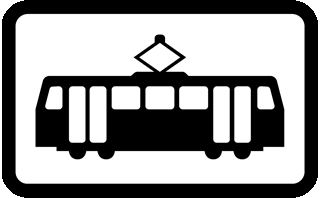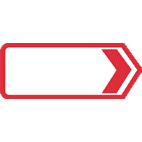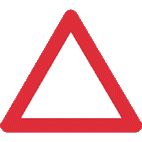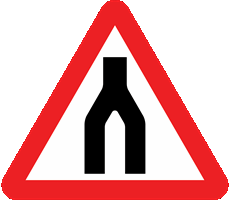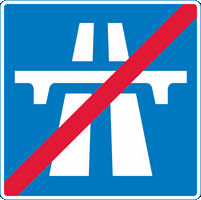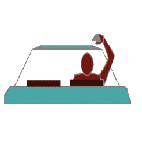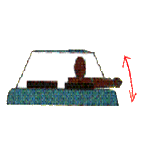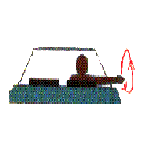You have 57 minutes to answer 50 multiple choice theory test questions. You need to answer at least 43 out of 50 questions correctly to pass. You can review your answer after each question or you can review all of your answers at the end of the test. Best of luck!
Test Quick View
Click on an answer to view the correct choice along with the explanation.
1. You wish to turn right ahead. Why should you take up the correct position in good time?
Mark one answer
B
C
D
Correct Answer: D
Explanation: If you wish to turn right into a side road take up your position in good time. Move to the centre of the road when it's safe to do so. This will allow vehicles to pass you on the left. Early planning will show other traffic what you intend to do.
Explanation: If you wish to turn right into a side road take up your position in good time. Move to the centre of the road when it's safe to do so. This will allow vehicles to pass you on the left. Early planning will show other traffic what you intend to do.
Correct Answer: A, C, E
Explanation: Trams are powered by electricity and therefore do not emit exhaust fumes. They are also much quieter than petrol or diesel engined vehicles and can carry a large number of passengers.
Explanation: Trams are powered by electricity and therefore do not emit exhaust fumes. They are also much quieter than petrol or diesel engined vehicles and can carry a large number of passengers.
Correct Answer: C
Explanation: In icy and snowy weather, your stopping distance will increase by up to ten times compared to good, dry conditions. Take extra care when braking, accelerating and steering, to cut down the risk of skidding.
Explanation: In icy and snowy weather, your stopping distance will increase by up to ten times compared to good, dry conditions. Take extra care when braking, accelerating and steering, to cut down the risk of skidding.
4. Motorcyclists will often look round over their right shoulder just before turning right. This is because
Mark one answer
B
C
D
Correct Answer: C
Explanation: If you see a motorcyclist take a quick glance over their shoulder, this could mean they are about to change direction. Recognising a clue like this helps you to be prepared and take appropriate action, making you safer on the road.
Explanation: If you see a motorcyclist take a quick glance over their shoulder, this could mean they are about to change direction. Recognising a clue like this helps you to be prepared and take appropriate action, making you safer on the road.
Correct Answer: B
Explanation: This sign doesn't tell you the speed limit in figures. You should know the speed limit for the type of road that you're on. Study your copy of The Highway Code.
Explanation: This sign doesn't tell you the speed limit in figures. You should know the speed limit for the type of road that you're on. Study your copy of The Highway Code.
Correct Answer: A
Explanation: Red rear reflectors show up when headlights shine on them. These are useful when you are parked at night but will only reflect if you park in the same direction as the traffic flow. Normally you should park on the left, but if you're in a one-way street you may also park on the right-hand side.
Explanation: Red rear reflectors show up when headlights shine on them. These are useful when you are parked at night but will only reflect if you park in the same direction as the traffic flow. Normally you should park on the left, but if you're in a one-way street you may also park on the right-hand side.
Correct Answer: D
Explanation: Road signs in the shape of a circle give orders. Those with a red circle are mostly prohibitive. The 'stop' sign is octagonal to give it greater prominence. Signs giving orders MUST always be obeyed.
Explanation: Road signs in the shape of a circle give orders. Those with a red circle are mostly prohibitive. The 'stop' sign is octagonal to give it greater prominence. Signs giving orders MUST always be obeyed.
Correct Answer: C
Explanation: The STOP sign is the only road sign that is octagonal. This is so that it can be recognised and obeyed even if it is obscured, for example by snow.
Explanation: The STOP sign is the only road sign that is octagonal. This is so that it can be recognised and obeyed even if it is obscured, for example by snow.
Correct Answer: A
Explanation: Don't leave moving into the left-hand lane until the last moment. Plan ahead and don't rely on other traffic letting you in.
Explanation: Don't leave moving into the left-hand lane until the last moment. Plan ahead and don't rely on other traffic letting you in.
Correct Answer: B
Explanation: You may cross the solid white line to pass a stationary vehicle, pedal cycle, horse or road maintenance vehicle if they are travelling at 10 mph or less. You may also cross the solid line to enter into a side road or access a property.
Explanation: You may cross the solid white line to pass a stationary vehicle, pedal cycle, horse or road maintenance vehicle if they are travelling at 10 mph or less. You may also cross the solid line to enter into a side road or access a property.
11. You approach a junction. The traffic lights are not working. A police officer gives this signal. You should
Mark one answer

B
C
D
Correct Answer: A
Explanation: If a police officer or traffic warden is directing traffic you must obey them. They will use the arm signals shown in The Highway Code. Learn what these mean and act accordingly.
Explanation: If a police officer or traffic warden is directing traffic you must obey them. They will use the arm signals shown in The Highway Code. Learn what these mean and act accordingly.
Correct Answer: B
Explanation: When you leave the motorway make sure that you check your speedometer. You may be going faster than you realise. Slow down and look out for speed limit signs.
Explanation: When you leave the motorway make sure that you check your speedometer. You may be going faster than you realise. Slow down and look out for speed limit signs.
Correct Answer: C
Explanation: If you're travelling on a dual carriageway that becomes a single carriageway road, reduce your speed gradually so that you aren't exceeding the limit as you enter. There might not be a sign to remind you of the limit, so make sure you know what the speed limits are for different types of roads and vehicles.
Explanation: If you're travelling on a dual carriageway that becomes a single carriageway road, reduce your speed gradually so that you aren't exceeding the limit as you enter. There might not be a sign to remind you of the limit, so make sure you know what the speed limits are for different types of roads and vehicles.
14. You have just passed these warning lights. What hazard would you expect to see next?
Mark one answer

B
C
D
Correct Answer: B
Explanation: These lights warn that children may be crossing the road to a nearby school. Slow down so that you're ready to stop if necessary.
Explanation: These lights warn that children may be crossing the road to a nearby school. Slow down so that you're ready to stop if necessary.
Correct Answer: D
Explanation: Never sound the horn aggressively. You MUST NOT sound it when driving in a built-up area between 11.30 pm and 7.00 am or when you are stationary, an exception to this is when another road user poses a danger. Do not scare animals by sounding your horn.
Explanation: Never sound the horn aggressively. You MUST NOT sound it when driving in a built-up area between 11.30 pm and 7.00 am or when you are stationary, an exception to this is when another road user poses a danger. Do not scare animals by sounding your horn.
Correct Answer: A
Explanation: A doctor attending an emergency may show a green flashing beacon on their vehicle. Give way to them when you can do so safely as they will need to reach their destination quickly. Be aware that they might pull over suddenly.
Explanation: A doctor attending an emergency may show a green flashing beacon on their vehicle. Give way to them when you can do so safely as they will need to reach their destination quickly. Be aware that they might pull over suddenly.
Correct Answer: C
Explanation: You should keep to the left and only use the right-hand lane if you're passing slower-moving traffic.
Explanation: You should keep to the left and only use the right-hand lane if you're passing slower-moving traffic.
18. You are travelling along the left-hand lane of a three-lane motorway. Traffic is joining from a slip road. You should
Mark one answer
B
C
D
Correct Answer: B
Explanation: You should move to another lane if it is safe to do so. This can greatly assist the flow of traffic joining the motorway, especially at peak times.
Explanation: You should move to another lane if it is safe to do so. This can greatly assist the flow of traffic joining the motorway, especially at peak times.
19. Planning your journey to avoid busy times has a number of advantages. One of these is
Mark one answer
B
C
D
Correct Answer: B
Explanation: Having a pleasant journey can have safety benefits. You will be less tired and stressed and this will allow you to concentrate more on your driving or riding.
Explanation: Having a pleasant journey can have safety benefits. You will be less tired and stressed and this will allow you to concentrate more on your driving or riding.
Correct Answer: A
Explanation: If there are no road signs or markings do not assume that you have priority. Remember that other drivers may assume they have the right to go. No type of vehicle has priority but it's courteous to give way to large vehicles. Also look out in particular for cyclists and motorcyclists.
Explanation: If there are no road signs or markings do not assume that you have priority. Remember that other drivers may assume they have the right to go. No type of vehicle has priority but it's courteous to give way to large vehicles. Also look out in particular for cyclists and motorcyclists.
21. You stop on the hard shoulder of a motorway and use the emergency telephone. Where's the best place to wait for help to arrive?
Mark one answer
B
C
D
Correct Answer: C
Explanation: When you're on the hard shoulder you're at risk of being injured by motorway traffic. The safest place to wait is away from the carriageway and hard shoulder, but near enough to see the emergency services arriving.
Explanation: When you're on the hard shoulder you're at risk of being injured by motorway traffic. The safest place to wait is away from the carriageway and hard shoulder, but near enough to see the emergency services arriving.
Correct Answer: D
Explanation: The vehicle excise licence (road tax) can be renewed at certain post offices, vehicle registration offices, online or by phone. When applying, make sure you have all the relevant valid documents, including a valid MOT test certificate where applicable.
Explanation: The vehicle excise licence (road tax) can be renewed at certain post offices, vehicle registration offices, online or by phone. When applying, make sure you have all the relevant valid documents, including a valid MOT test certificate where applicable.
23. You are going through a long tunnel. What will warn you of congestion or an incident ahead?
Mark one answer
B
C
D
Correct Answer: D
Explanation: Follow the instructions given by the signs or by tunnel officials. In congested tunnels a minor incident can soon turn into a major one with serious or even fatal results.
Explanation: Follow the instructions given by the signs or by tunnel officials. In congested tunnels a minor incident can soon turn into a major one with serious or even fatal results.
24. At night you see a pedestrian wearing reflective clothing and carrying a bright red light. What does this mean?
Mark one answer
B
C
D
Correct Answer: C
Explanation: The people on the walk should be keeping to the left, but don't assume this. Pass slowly, make sure you have time to do so safely. Be aware that the pedestrians have their backs to you and may not know that you're there.
Explanation: The people on the walk should be keeping to the left, but don't assume this. Pass slowly, make sure you have time to do so safely. Be aware that the pedestrians have their backs to you and may not know that you're there.
B
C
D
Correct Answer: D
Explanation: When someone is injured, any movement which is not absolutely necessary should be avoided since it could make injuries worse. Unless it is essential, it's generally safer to leave a motorcyclist's helmet in place.
Explanation: When someone is injured, any movement which is not absolutely necessary should be avoided since it could make injuries worse. Unless it is essential, it's generally safer to leave a motorcyclist's helmet in place.
Correct Answer: A, C
Explanation: Keeping your vehicle's tyres correctly inflated is a legal requirement. Driving with correctly inflated tyres will use less fuel and your vehicle will brake more safely.
Explanation: Keeping your vehicle's tyres correctly inflated is a legal requirement. Driving with correctly inflated tyres will use less fuel and your vehicle will brake more safely.
Correct Answer: A
Explanation: You should always consider the conditions and drive accordingly.
Explanation: You should always consider the conditions and drive accordingly.
B
C
D
Correct Answer: B
Explanation: You have shown that you are a risk to yourself and others on the road. For this reason insurance companies may charge you a higher premium.
Explanation: You have shown that you are a risk to yourself and others on the road. For this reason insurance companies may charge you a higher premium.
29. You are about to reverse into a side road. A pedestrian wishes to cross behind you. You should
Mark one answer
B
C
D
Correct Answer: A
Explanation: If you need to reverse into a side road try to find a place that's free from traffic and pedestrians. Look all around before and during the manoeuvre. Stop and give way to any pedestrians who want to cross behind you. Avoid waving them across, sounding the horn, flashing your lights or giving any misleading signals that could lead them into a dangerous situation.
Explanation: If you need to reverse into a side road try to find a place that's free from traffic and pedestrians. Look all around before and during the manoeuvre. Stop and give way to any pedestrians who want to cross behind you. Avoid waving them across, sounding the horn, flashing your lights or giving any misleading signals that could lead them into a dangerous situation.
30. You are driving in town. There is a bus at the bus stop on the other side of the road. Why should you be careful?
Mark one answer
B
C
D
Correct Answer: A
Explanation: If you see a bus ahead watch out for pedestrians. They may not be able to see you if they're crossing from behind the bus.
Explanation: If you see a bus ahead watch out for pedestrians. They may not be able to see you if they're crossing from behind the bus.
Correct Answer: C
Explanation: Don't forget that you're towing a trailer. If you're towing a small, light, trailer, it won't reduce your vehicle's performance by very much. However, strong winds or buffeting from large vehicles might cause the trailer to snake from side to side. Be aware of your speed and don't exceed the lower limit imposed.
Explanation: Don't forget that you're towing a trailer. If you're towing a small, light, trailer, it won't reduce your vehicle's performance by very much. However, strong winds or buffeting from large vehicles might cause the trailer to snake from side to side. Be aware of your speed and don't exceed the lower limit imposed.
32. While driving, you intend to turn left into a minor road. On the approach you should
Mark one answer
B
C
D
Correct Answer: C
Explanation: Don't swing out into the centre of the road in order to make the turn. This could endanger oncoming traffic and may cause other road users to misunderstand your intentions.
Explanation: Don't swing out into the centre of the road in order to make the turn. This could endanger oncoming traffic and may cause other road users to misunderstand your intentions.
Correct Answer: A
Explanation: You may decide to turn your vehicle around by reversing into an opening or side road. When you reverse, always look behind and all around and watch for pedestrians. Don't reverse from a side road into a main road. You MUST NOT reverse further than is necessary.
Explanation: You may decide to turn your vehicle around by reversing into an opening or side road. When you reverse, always look behind and all around and watch for pedestrians. Don't reverse from a side road into a main road. You MUST NOT reverse further than is necessary.
Correct Answer: C
Explanation: There may be occasions where other road users are unable to see your indicator, such as in bright sunlight or at a busy, complicated junction. In these cases a hand signal will help others to understand your intentions.
Explanation: There may be occasions where other road users are unable to see your indicator, such as in bright sunlight or at a busy, complicated junction. In these cases a hand signal will help others to understand your intentions.
35. The legal minimum depth of tread for car tyres over three quarters of the breadth is
Mark one answer
B
C
D
Correct Answer: B
Explanation: Tyres must have sufficient depth of tread to give them a good grip on the road surface. The legal minimum for cars is 1.6 mm. This depth should be across the central three quarters of the breadth of the tyre and around the entire circumference.
Explanation: Tyres must have sufficient depth of tread to give them a good grip on the road surface. The legal minimum for cars is 1.6 mm. This depth should be across the central three quarters of the breadth of the tyre and around the entire circumference.
36. You are carrying two 13 year old children and their parents in your car. Who is responsible for seeing that the children wear seat belts?
Mark one answer
B
C
D
Correct Answer: D
Explanation: Seat belts save lives and reduce the risk of injury. If you are carrying passengers under 14 years of age it's your responsibility as the driver to ensure that their seat belts are fastened or they are seated in an approved child restraint.
Explanation: Seat belts save lives and reduce the risk of injury. If you are carrying passengers under 14 years of age it's your responsibility as the driver to ensure that their seat belts are fastened or they are seated in an approved child restraint.
Correct Answer: D
Explanation: If the wheels of your vehicle lock they will not grip the road and you will lose steering control. In good conditions the anti-lock system will prevent the wheels locking and allow you to retain steering control.
Explanation: If the wheels of your vehicle lock they will not grip the road and you will lose steering control. In good conditions the anti-lock system will prevent the wheels locking and allow you to retain steering control.
Correct Answer: C
Explanation: Your vehicle will use less fuel if you avoid heavy acceleration. The higher the engine revs, the more fuel you will use. Using the same gear, a vehicle travelling at 70mph will use up to 30% more fuel to cover the same distance, than at 50mph. However, don't travel so slowly that you inconvenience or endanger other road users.
Explanation: Your vehicle will use less fuel if you avoid heavy acceleration. The higher the engine revs, the more fuel you will use. Using the same gear, a vehicle travelling at 70mph will use up to 30% more fuel to cover the same distance, than at 50mph. However, don't travel so slowly that you inconvenience or endanger other road users.
B
C
D
Correct Answer: A
Explanation: When you leave your car, always engage the steering lock. This increases the security of your vehicle, as the ignition key is needed to release the steering lock.
Explanation: When you leave your car, always engage the steering lock. This increases the security of your vehicle, as the ignition key is needed to release the steering lock.
Correct Answer: D
Explanation: If you start to feel tired, stop at a safe place for a rest break. Every year many fatal incidents are caused by drivers falling asleep at the wheel.
Explanation: If you start to feel tired, stop at a safe place for a rest break. Every year many fatal incidents are caused by drivers falling asleep at the wheel.
Correct Answer: D
Explanation: An unlocked car is an open invitation to thieves. Leaving the keys in the ignition not only makes your car easy to steal, it could also invalidate your insurance.
Explanation: An unlocked car is an open invitation to thieves. Leaving the keys in the ignition not only makes your car easy to steal, it could also invalidate your insurance.
42. You are driving on an icy road. What distance should you drive from the car in front?
Mark one answer
B
C
D
Correct Answer: D
Explanation: Don't travel in icy or snowy weather unless your journey is necessary.Drive extremely carefully when roads are or may be icy. Stopping distances can be ten times greater than on dry roads.
Explanation: Don't travel in icy or snowy weather unless your journey is necessary.Drive extremely carefully when roads are or may be icy. Stopping distances can be ten times greater than on dry roads.
Correct Answer: A, B, C
Explanation: By looking well ahead and recognising hazards early you can avoid last-minute harsh braking. Watch the traffic flow and look well ahead for potential hazards so you can control your speed accordingly. Avoid over-revving the engine and accelerating harshly as this increases wear to the engine and uses more fuel.
Explanation: By looking well ahead and recognising hazards early you can avoid last-minute harsh braking. Watch the traffic flow and look well ahead for potential hazards so you can control your speed accordingly. Avoid over-revving the engine and accelerating harshly as this increases wear to the engine and uses more fuel.
44. You want to turn left at this junction. The view of the main road is restricted. What should you do?
Mark one answer

B
C
D
Correct Answer: A
Explanation: You should slow right down, and stop if necessary, at any junction where the view is restricted. Edge forward until you can see properly. Only then can you decide if it is safe to go.
Explanation: You should slow right down, and stop if necessary, at any junction where the view is restricted. Edge forward until you can see properly. Only then can you decide if it is safe to go.
45. You should leave at least a two-second gap between your vehicle and the one in front when conditions are
Mark one answer

B
C
D
Correct Answer: C
Explanation: In good, dry conditions an alert driver who's driving a vehicle with tyres and brakes in good condition, needs to keep a distance of at least two seconds from the car in front.
Explanation: In good, dry conditions an alert driver who's driving a vehicle with tyres and brakes in good condition, needs to keep a distance of at least two seconds from the car in front.
Correct Answer: B
Explanation: A security-coded radio can deter thieves as it is likely to be of little use when removed from the vehicle.
Explanation: A security-coded radio can deter thieves as it is likely to be of little use when removed from the vehicle.
Correct Answer: B
Explanation: If you suspect a fire in the engine compartment you should pull up as safely and as quickly as possible. DO NOT open the bonnet as this will fuel the fire further. Get any passengers out of the vehicle and dial 999 immediately to contact the fire brigade.
Explanation: If you suspect a fire in the engine compartment you should pull up as safely and as quickly as possible. DO NOT open the bonnet as this will fuel the fire further. Get any passengers out of the vehicle and dial 999 immediately to contact the fire brigade.
48. Your vehicle is fitted with anti-lock brakes. To stop quickly in an emergency you should
Mark one answer
B
C
D
Correct Answer: C
Explanation: Once you have applied the brake keep your foot firmly on the pedal. Releasing the brake and reapplying it will disable the anti-lock brake system.
Explanation: Once you have applied the brake keep your foot firmly on the pedal. Releasing the brake and reapplying it will disable the anti-lock brake system.
B
C
D
Correct Answer: A
Explanation: You should make all efforts to ensure a correct child restraint is used, with very few exceptions. If in specific circumstances one is not available, then an adult seat belt MUST be used. Unrestrained objects, including people, can be thrown violently around in a collision, and may cause serious injury or even death!
Explanation: You should make all efforts to ensure a correct child restraint is used, with very few exceptions. If in specific circumstances one is not available, then an adult seat belt MUST be used. Unrestrained objects, including people, can be thrown violently around in a collision, and may cause serious injury or even death!
B
C
D
Correct Answer: A
Explanation: Never stop on the hard shoulder to rest. If there is no service station for several miles, leave the motorway at the next exit and find somewhere safe and legal to pull over.
Explanation: Never stop on the hard shoulder to rest. If there is no service station for several miles, leave the motorway at the next exit and find somewhere safe and legal to pull over.



